Devil’s Canyon Review: Intel Core i7-4790K and i5-4690K
by Ian Cutress on July 11, 2014 10:00 AM EST- Posted in
- CPUs
- Intel
- Haswell
- i7
- Overclocking
- Devil's Canyon
- i5
- 4790K
- 4690K
Discrete GPU Gaming
When comparing CPUs to APUs, one strength shown by team Blue in the past is the discrete GPU performance. However even when using dual graphics cards at a 1920x1080p resolution, we seem to have hit a wall where extra CPU performance does not necessarily translate to more frames per second. Our results below show little difference between the Haswell processors, and we need to go down to a 2.0 GHz i7 or a 3.5 GHz i3 CPU to see a significant drop in frame rates. The biggest benefit from overclocking seems to be F1 2013 minimum frame rates.
F1 2013
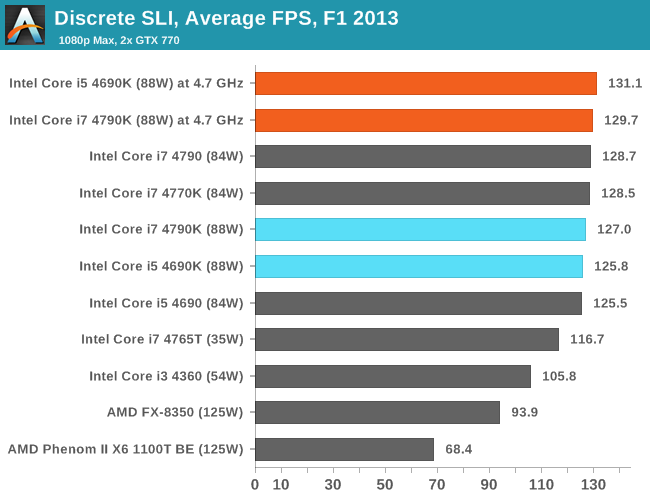

Bioshock Infinite

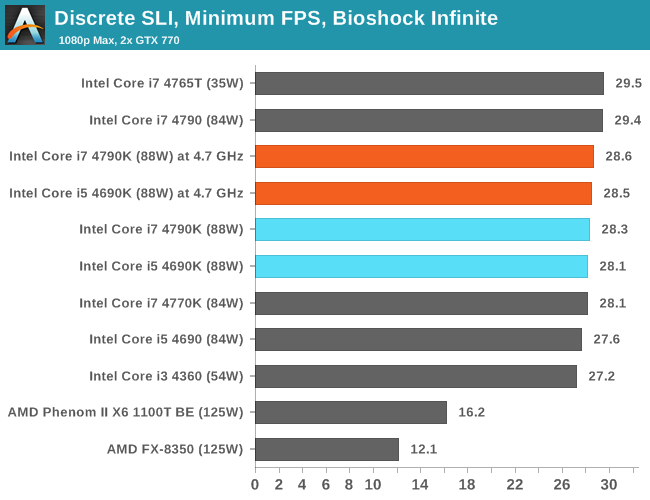
Tomb Raider
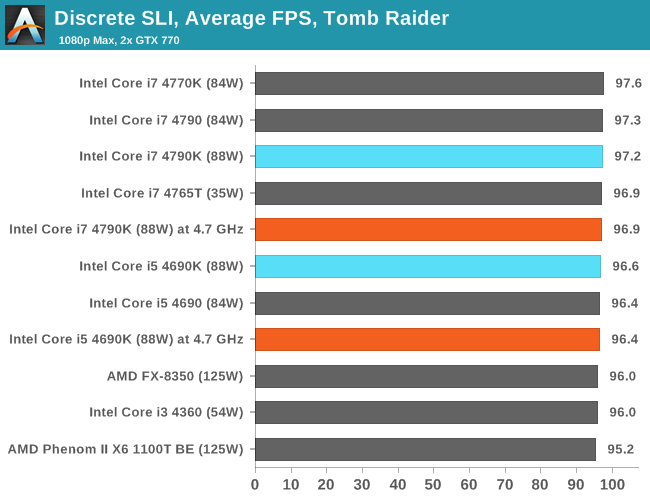
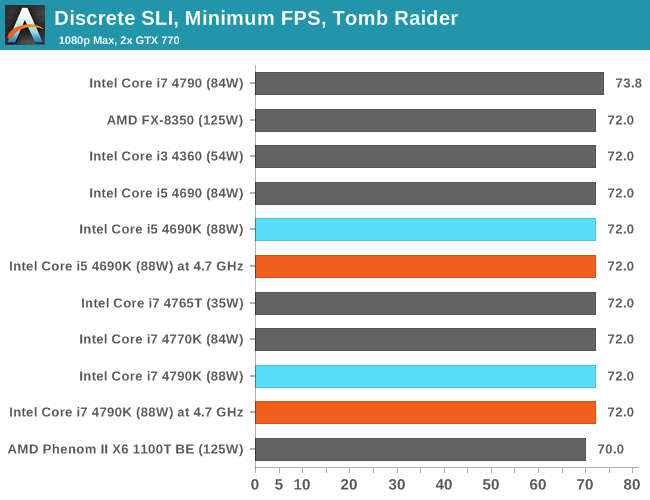
Sleeping Dogs
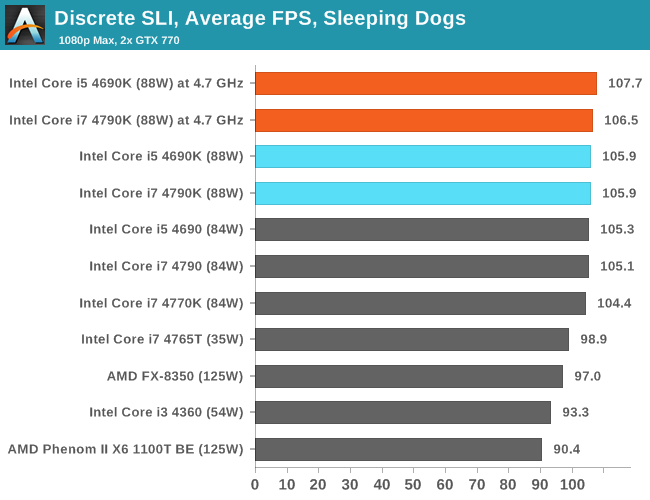
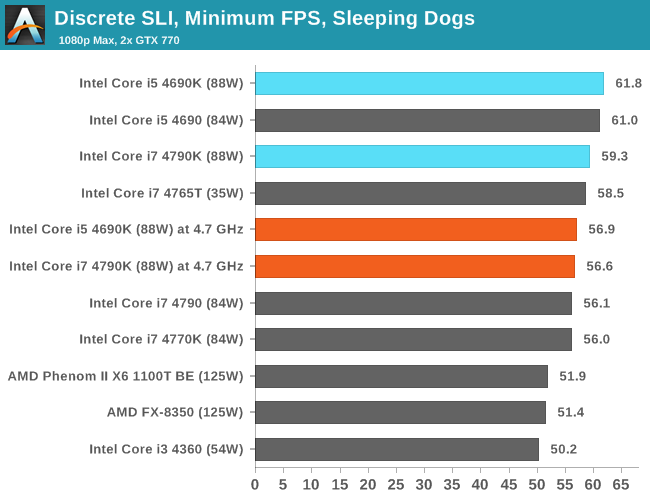
Company of Heroes 2
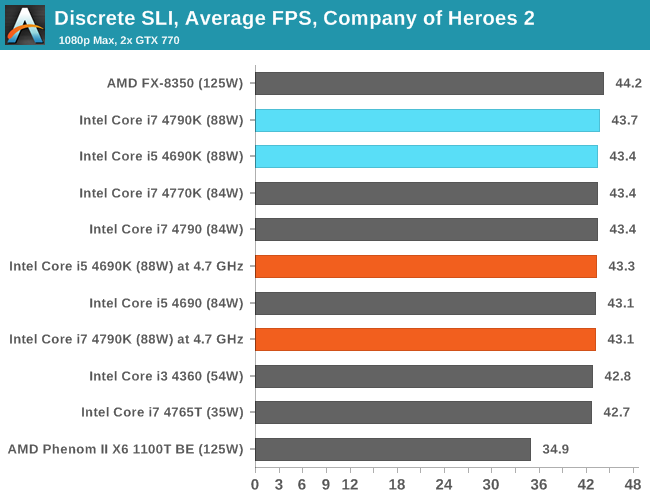

Battlefield 4

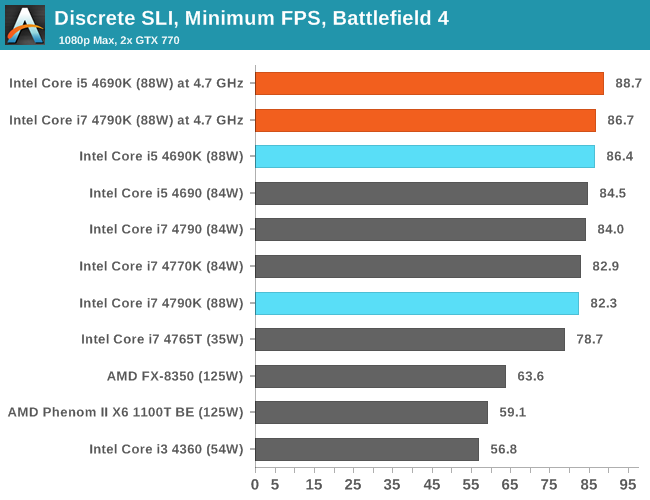










117 Comments
View All Comments
FlushedBubblyJock - Thursday, November 20, 2014 - link
What vid card are you using is my question.If you've got a 970 or a 290x already then it might be worth it to jump early.
HollyDOL - Monday, July 14, 2014 - link
Umm, please fix the pseudo-code on page 2:try {
OS.Boot();
OS.PovRay.Test();
OS.OCCT.Test();
} catch {
CPU.CoreVoltage += 0.025;
continue; // exit do while loop
}
CPU.Multiplier++;
Increasing multiplier only makes sense when you successfully passed the exception block ;-)
Djibrille - Friday, July 25, 2014 - link
I was thinking the same thing.That continue statement does not exit the do loop it just returns to the beginning, so the comment is not accurate either. ;)
HollyDOL - Friday, July 25, 2014 - link
ye true, actually incrementing that voltage float (in case it is a floating point variable) is wrong too since it leads to FP errors, so it should be like:{
CPU.CoreVoltage = baseVoltage + (++voltageMultiplicator * 0.025);
continue; // skip to next loop iteration
}
:-)
Djibrille - Saturday, July 26, 2014 - link
Nice!Maybe that's taking it too far, it's just pseudo-code albeit pretty close to real c/c++/java code.
Logical errors I think he needs to fix though, otherwise including the code is pointless.
rms141 - Tuesday, July 15, 2014 - link
"It would seem to offer higher limits for overclocking, although your mileage may vary. For Ivy Bridge users, the rewards are even greater. However, gamers at 1920x1080 resolutions gain very little."If this is true, then why are there no Ivy Bridge CPUs included in the benchmarks? Not even the venerable i5 3570k? It's very strange to include a single Sandy Bridge CPU, but no Ivy Bridge CPUs.
FlushedBubblyJock - Thursday, November 20, 2014 - link
The 3570K is faster on the 1155 SB socket, so like it's a given it's covered and in better shape, but yeah, it might be too close to the new breed... lol... leave it out so everything looks like real progress.Hrel - Tuesday, July 15, 2014 - link
Seems like Intel is slowing down their upgrade cycle. These are basically stepping revisions (A1, A2, A3 etc...) being marketed as new CPU's. I guess their tick/tock is going bi-annual. Cause Haswell came out last year, unless you wanna be technical, then it came out in 2012.johnpombrio - Sunday, July 27, 2014 - link
I might just remove my Haswell that is o/c to 4.2GHz and stick in a Devil's Canyon. Why? To get rid of the noisy water cooler fans. The higher I o/c, the noisier the fans and 4.4 is max anyways without occasionally bumping into the 90 C headbump. I also would not bother to o/c the 4790K chip and put the CPU back to an air cooler. This would be my FIRST computer build that I have NOT o/c in the past 25 years!namec - Monday, July 28, 2014 - link
You hit the nail squarely on the head, I think, JP. Devil's Canyon is the first stock-clocked 4.0 ghz CPU, and it has a 400 mhz on-demand overclock (Turbo). This all comes with a factory warranty!I was waiting for Broadwell, but aside from 30% better efficiency (which I covet), it may have little to offer. At least until the 5790K comes out.
The days of the 40% overclock are past. Sure the G3258 (factory at 3.2ghz) can oc to 4.7 ghz (which btw is about the same stable top clock for 4790K), but Intel could have released the G3258 at 4.2 ghz stock. Then some would complain that it does not oc well.